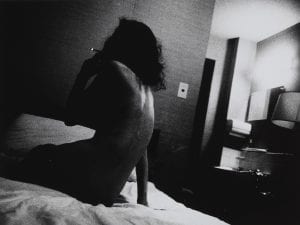After the devastation caused by World War II, Britain was in desperate need of hope, optimism and re-development. During the course of the war Britain suffered the tragic loss of 383,800 soldiers’ lives. The desire to raise Britain from rubble and ash and restore its former greatness found voice through the Festival of Britain organised by the labour government of Clement Atlee in the summer of 1951, exactly one hundred years after the Great Exhibition of Britain in 1851. The exhibition Art and Optimism in 1950s Britain temporarily on display at Middlesbrough Institute of Modern Art aims to do the same for contemporary Britain. Britain’s post-war period is reminded to visitors through a vast array of works of art, furniture, crockery and memorabilia.
Entering the first gallery the audience is faced with a warm yellow wall on which Francis Bacon’s Study for Portrait of Van Gogh VI (1957) hangs; an air of loss is exuded from the oil on canvas painting, the backdrop is bright and sunny while the foreground is in shades of red, black and green. It immediately reminds the viewer that blood has been spilt. On the adjacent wall to the left, several post-war posters herald that the British people have nothing to be worried about. An example is one issued by His Majesty’s Stationary Office in 1951 and reads, New Homes Rise from London’s Ruins. English textile and furniture designer Ernest Race’s Antelope Chair is situated on a wooden plywood structure designed by OMMX Architects and inspired by the work of British artist and architect, Victor Pasmore, whose collaborative efforts to re-build Britain will always be remembered for the ambition and authenticity they carried forth to our day. In Gallery Three, Pasmore’s Apollo Pavilion, a concrete centrepiece for the Sunny Blunts estate in Peterlee, County Durham, is conveyed to the exhibition through old black and white photographs.
Exuding a much darker feeling with its royal blue walls, Gallery Two hosts the small-scale yet overwhelmingly detailed Lucian Freud painting Girl in a Green Dress (1954) as well as the timeless painted steel Anthony Caro sculpture titled Twenty Four Hours. The reduced colour palette of the post-war period echoes throughout the gallery. The difficulty of the times is emphasised through each work. Lynn Chadwick’s Three Studies for The Seasons (1956) as well as the consequent iron sculpture The Seasons (1956) resonates a sense of withering optimism in accordance with the spirit of the times.
Just then, while heading towards Gallery Three, a lady with short red hair approaches me. In her distinctly northern accent she says, “Have you seen this painting yet?” directing my attention to the Scullery Sink (1954) by Glynn Porteous. I inform her that I am still to view it and she becomes incredibly excited; her eyes sparkle with memories as she begins to tell me the story behind the soul-penetrating painting. Shades of yellow, brown and greyish white denote the post-war depression and poverty while the proudly standing scullery sink recalls to the mind how having such a sink was in fact a luxury in those days. Soon after, Rene; whose name means “reborn” in French, tells me she was the wife of late Glynn Porteous. I later find out from museum staff that she has been working at MIMA for over four years. The coin drops; it all makes sense… With Rene’s enthusiasm and energy, Porteous’s work gains momentum and lives on every time she introduces visitors to the painting and tells history of Middlesbrough through her own experiences.
Another painting that really shakes one to the bone is the Early Morning Shift (1959) by Tom McGuiness. In the dark blue oil painting, the northern chill is conveyed with skilful brush strokes as tired and half-asleep workers head to work through streets lined with brick houses. Gallery Four is provides a uniquely integrating experience as it includes the real-life installation of a 1950s living room. Hats hang on the wall covered with utterly kitsch wallpaper; an old suitcase snuggly houses a fur coat; a mirrored dresser boasts hair brushes, bow ties, gloves, strings of pearls; a two-seater brown suede couch is situated in front of a television showing 1950s movies. His Master’s Voice-make record player, a clock set to 16:40 and an old-fashioned hair- dryer are amongst the memorabilia used to create the feel of this long-forgotten time. Dedicated mostly to furniture, crockery, accessories, adverts from magazines as well as magazine covers, Gallery Four also includes some interesting pieces of art such as Eduardo Paolozzi’s Jesus Colour by Numbers (1965-70) and Richard Hamilton’s Just what it is that makes today’s home so different, so appealing? I ask myself the same question, as I consider just what it is that makes today’s home so different, so appealing? Are we more understanding, are we more comfortable, and are we more peaceful for having all the contemporary luxury that we seem to enjoy without a moment’s consideration?”
Art and Optimism in 1950s Britain, meticulously organised and curated by MIMA, is not merely an exhibition displaying art, furniture and memorabilia from the 1950s. It’s a ground-breaking collective exhibition with loans from numerous museums and art establishments that reminds us of the past so we can draw parallels between now and then, and question how well contemporary British society would fare if another world war took place. By bringing together visitors from different generations and pooling a great variety of artistic styles, MIMA succeeds in offering a once in a life time opportunity to view some of the most important art works of the 20th century through the lens of an unjustly abandoned context: the possibility of life and art after war.
Art and Optimism in 1950s Britain, until 29 June, MIMA, Centre Square, Middlesbrough, TS1 2AZ.
Hande Eagle
Credits
1. Installation shot courtesy of MIMA.





